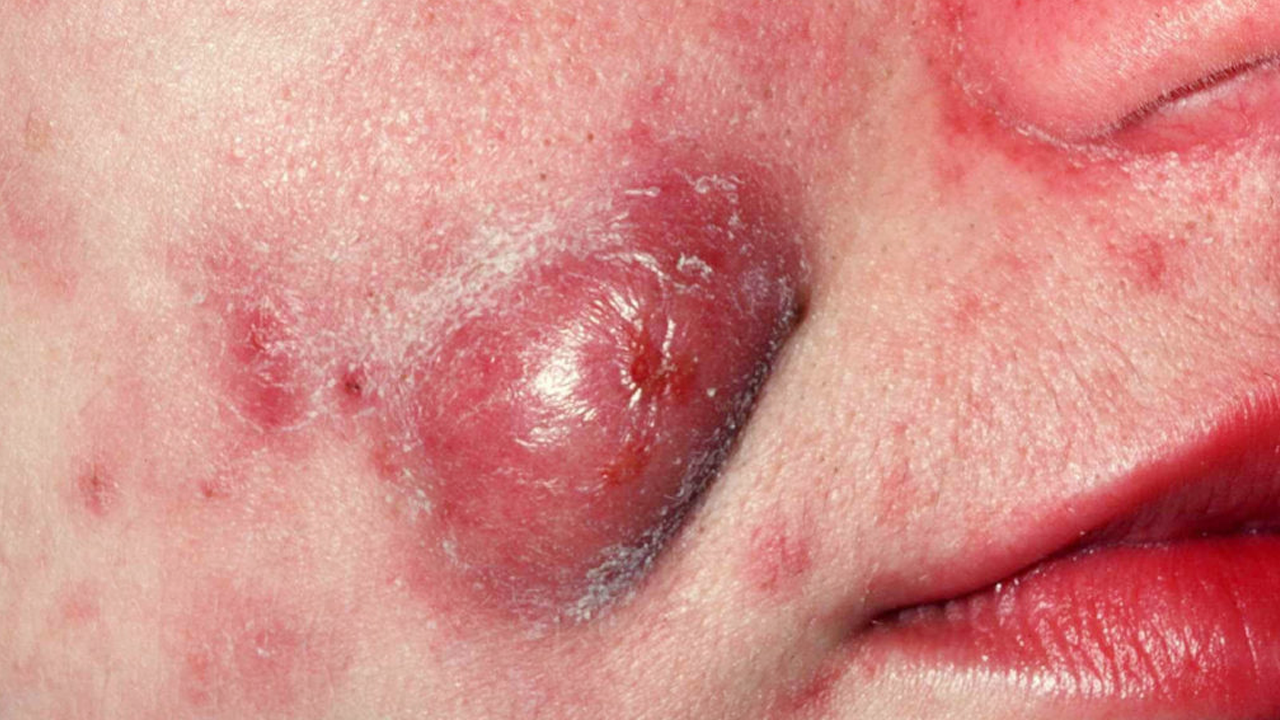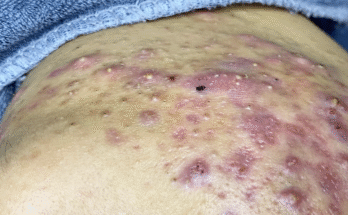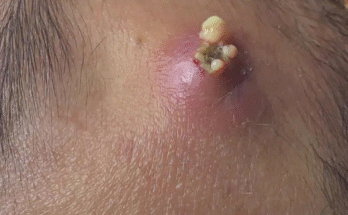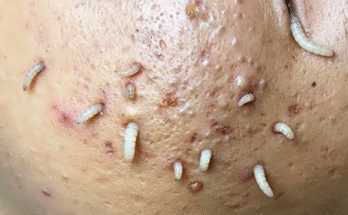Understanding Acne Vulgaris: A Comprehensive Guide
Acne vulgaris, commonly known as acne, is a prevalent skin condition impacting the skin’s oil glands. This condition often persists for extended periods, manifesting as raised spots or pus-filled bumps. While the face is most frequently affected, the upper arms, trunk, and back can also be involved.
The Genesis of a Pimple: Understanding Acne Formation
The development of acne is a multifaceted process. It begins with the formation of a comedo, better known as a pimple. This occurs when the oil-producing glands overreact to normal hormone levels. This reaction is often exacerbated by the presence of Cutibacterium acnes bacteria, triggering inflammation.
Several factors contribute to this process:
- Medication: Certain medications, including lithium, steroids, and anticonvulsants, can worsen acne.
- Sun Exposure: Excessive sun exposure can negatively impact acne-prone skin.
- Clothing: Tight clothing, such as shoulder pads, headbands, or underwire bras, can trap oil and contribute to breakouts.
- Cosmetics: Oil-based cosmetics and excessive facial massage can clog pores.
- Hormonal Imbalances: Conditions like polycystic ovarian syndrome (PCOS) and pregnancy can significantly influence acne severity. Premenstrual acne flares are common in approximately 70% of women due to pore swelling.
- Genetics: Genetic predisposition plays a role, affecting the type of fatty acids in skin oils.
- Harsh Cleansing: Aggressive scrubbing with harsh soaps and detergents can irritate the skin and worsen acne.
- Diet: Research suggests a possible link between acne and diet, particularly dairy consumption and high-sugar foods, potentially due to growth-promoting and hormone-boosting substances. However, the connection between chocolate consumption and acne remains unsubstantiated.
- Stress: High stress levels can exacerbate acne due to increased stress hormones.
- Insulin Resistance: Individuals with insulin resistance may experience increased skin oil production, contributing to acne development. However, the relationship between body weight and acne remains inconclusive.
Acne Vulgaris: Prevalence and Risk Factors
Acne is most prevalent during adolescence and young adulthood. A significant percentage of teenagers (35-90%) experience acne, typically starting between ages 7 and 12 and often resolving by the thirties. However, acne can persist into adulthood or even begin later in life. Teenage acne is more common in boys, while adult acne is more frequently observed in women. Urban populations tend to exhibit higher rates of acne compared to rural populations.
Approximately 20% of individuals with acne experience severe symptoms, leading to scarring. Ethnic variations exist; Asians and Africans may experience more severe acne, while mild acne is more common among Caucasians. Darker skin tones are more prone to acne-related hyperpigmentation (dark spots). Infantile acne is relatively common in babies but usually resolves spontaneously. Acne in children aged 1-6 warrants further investigation as it might indicate an underlying health issue.
Recognizing Acne: Signs and Symptoms
Acne typically appears in areas with high concentrations of oil glands, including the face, neck, chest, upper back, and arms. Severity is graded as follows:
- Grade 1 (Comedones): Open (blackheads) or closed (whiteheads) comedones.
- Grade 2 (Papules): Small, red, inflamed bumps.
- Grade 3 (Pustules): Pus-filled bumps.
- Grade 4 (Nodulocystic Acne): Severe acne with large, interconnected pustules and cysts.
Severity assessment considers psychological impact, lesion type, scarring, oozing, and treatment response. Severe acne is characterized by large, inflamed bumps (nodules) and pus-filled lesions, particularly when accompanied by scarring. The affected area can range from a few comedones to numerous inflamed nodules, potentially leading to depressed, hypertrophic, or keloid scars. Post-inflammatory hyperpigmentation is also a common consequence, especially in darker skin tones.
Rare and Severe Forms of Acne
Beyond common acne vulgaris, several rarer forms exist:
- Acne conglobata: A severe form characterized by large inflamed comedones, cysts, and abscesses, predominantly affecting young men.
- Acne fulminans (acne maligna): A rare, acute condition involving painful, ulcerating, and bleeding acne. It may be associated with fever, polyarthritis, and blood/bone abnormalities.
- Acne excoriée: Often seen in young women with mental health conditions, involving compulsive picking and scarring of mild acne.
- Infantile acne: Appears between 3 and 6 months of age due to hormonal fluctuations.
Rare syndromes linked to acne include SAPHO syndrome (arthritis/bone inflammation) and PAPA syndrome (sterile pyogenic arthritis and pyoderma gangrenosum). Diagnosis requires a thorough patient history, including acne onset, medical history, previous treatments, lifestyle, hormonal imbalances, and emotional impact, along with a skin examination.
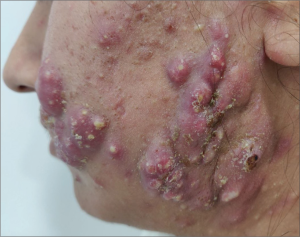
Diagnosis and Testing
Acne vulgaris is typically diagnosed through a physical examination. However, further testing may be necessary if underlying conditions are suspected, such as hyperandrogenism (excess male hormones). A skin biopsy is usually not required. Women considering pregnancy should disclose their medical history, including hirsutism (excessive body hair) or dysmenorrhea (painful periods), to enable appropriate hormonal testing (testosterone, LH, FSH, DHEA). Suddenly appearing severe acne unresponsive to treatment may indicate an ovarian or adrenal tumor, requiring laboratory and imaging tests. Acne fulminans necessitates a comprehensive blood count, liver function tests, and inflammatory markers (ESR, CRP). Additional tests (pregnancy test, cholesterol/triglyceride levels, X-rays) may be indicated depending on symptoms, particularly when isotretinoin is considered.
Treatment Strategies for Acne Vulgaris
Acne treatment begins with a thorough consultation to establish realistic expectations.
- Treatment Timeline: Improvement usually takes 2-3 months of consistent treatment. The goal isn’t complete acne clearance but reduction of breakouts and prevention of new ones.
- Long-Term Management: Most treatments manage, rather than cure, acne, requiring long-term maintenance.
- Skincare Practices: Gentle cleansers should be used; harsh soaps and scrubbing should be avoided. Picking or scratching should also be avoided to prevent scarring.
- Dietary Considerations: While research suggests a potential link between milk and high-glycemic diets and acne, there are no definitive dietary recommendations.
Treatment approaches vary depending on severity:
- Mild Acne: Topical treatments are usually sufficient, including retinoids (vitamin A derivatives), topical antibiotics, and benzoyl peroxide.
- Moderate-to-Severe Acne: Topical and systemic treatments are typically employed. Systemic therapies include oral antibiotics, hormonal therapies, and oral isotretinoin. These are usually reserved for more severe cases or treatment failures.
- Scar Treatment: For scarring or discolouration, procedures such as chemical peels, laser therapy, skin reconstruction, or filler injections may be considered.
Differentiating Acne Vulgaris from Other Skin Conditions
Several conditions mimic acne but require distinct treatment approaches:
- Rosacea: Causes redness, not blackheads.
- Perioral dermatitis: Red bumps around the mouth, but not on the lip edge.
- Demodex folliculitis: Inflammatory bumps and pustules, unresponsive to typical acne/rosacea treatments.
- Facial angiofibroma (tuberous sclerosis): Pink/red bumps on the cheeks/nose, usually in children.
- Pseudofolliculitis barbae: Red bumps, pustules, and scarring in the beard area.
- Nevus comedonicus: Cluster of blackheads, often in babies/children.
- Sebaceous hyperplasia: Small yellowish bumps on the forehead/cheeks.
- Skin growths from hair follicles (trichoepithelioma, trichodiscoma, fibrofolliculoma): Flesh-colored bumps.
- Favre-Racouchot syndrome: Blackheads on upper cheeks, often due to sun damage in elderly individuals.
Prognosis and Potential Complications
With appropriate treatment, acne typically has a favorable prognosis. However, the emotional impact can be significant, with acne and scarring potentially leading to anxiety and depression. Acne scar treatment can be challenging. A Swedish study suggests a potential link between teenage acne in boys and increased prostate cancer risk later in life.
Potential complications include:
- Psychological effects: Depression, anxiety, and low self-esteem.
- Acne fulminans: Acute eruption of large inflammatory nodules, ulcers, and bleeding. May be associated with fever, bone pain, joint pain, and blood abnormalities.
- Solid facial edema (Morbihan’s disease): Redness and swelling of the face with periods of flare-ups and remission.
- Gram-negative folliculitis: Occurs in patients on long-term systemic antibiotics for acne, leading to antibiotic resistance.
Managing acne requires a holistic approach, combining understanding the condition, consistent skincare, and individualized treatment tailored to severity and individual needs.
